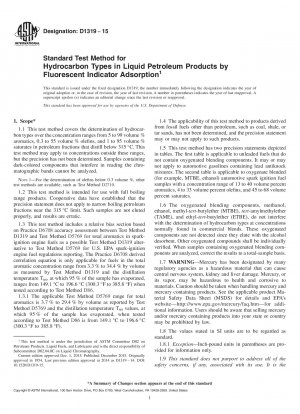ASTM D1319-15
Standard Test Method for Hydrocarbon Types in Liquid Petroleum Products by Fluorescent Indicator Adsorption
- Standard No.
- ASTM D1319-15
- Release Date
- 2015
- Published By
- American Society for Testing and Materials (ASTM)
- Status
- Replace By
- ASTM D1319-18
- Latest
- ASTM D1319-20a
- Scope
5.1 The determination of the total volume8201;percent of saturates, olefins, and aromatics in petroleum fractions is important in characterizing the quality of petroleum fractions as gasoline blending components and as feeds to catalytic reforming processes. This information is also important in characterizing petroleum fractions and products from catalytic reforming and from thermal and catalytic cracking as blending components for motor and aviation fuels. This information is also important as a measure of the quality of fuels, such as specified in Specification D1655.
1.1 This test method covers the determination of hydrocarbon types over the concentration ranges from 5 to 99 volume8201;% aromatics, 0.3 to 55 volume8201;% olefins, and 1 to 95 volume8201;% saturates in petroleum fractions that distill below 3158201;°C. This test method may apply to concentrations outside these ranges, but the precision has not been determined. Samples containing dark-colored components that interfere in reading the chromatographic bands cannot be analyzed.
Note 1: For the determination of olefins below 0.3 volume %, other test methods are available, such as Test Method D2710.
1.2 This test method is intended for use with full boiling range products. Cooperative data have established that the precision statement does not apply to narrow boiling petroleum fractions near the 3158201;°C limit. Such samples are not eluted properly, and results are erratic.
1.3 This test method includes a relative bias section based on Practice D6708 accuracy assessment between Test Method D1319 and Test Method D5769 for total aromatics in spark-ignition engine fuels as a possible Test Method D1319 alternative to Test Method D5769 for U.S. EPA spark-ignition engine fuel regulations reporting. The Practice D6708 derived correlation equation is only applicable for fuels in the total aromatic concentration range from 3.38201;% to 34.48201;% by volume as measured by Test Method D1319 and the distillation temperature T95, at which 95 % of the sample has evaporated, ranges from 149.18201;°C to 196.68201;°C (300.38201;°F to 385.88201;°F) when tested according to Test Method D86.
1.3.1 The applicable Test Method D5769 range for total aromatics is 3.78201;% to 29.48201;% by volume as reported by Test Method D5769 and the distillation temperature T95 values, at which 958201;% of the sample has evaporated, when tested according to Test Method D86 is from 149.18201;°C to 196.68201;°C (300.38201;°F to 385.88201;°F).
1.4 The applicability of this test method to products derived from......
ASTM D1319-15 Referenced Document
- ASTM D1655 Standard Specification for Aviation Turbine Fuels
- ASTM D2710 Standard Test Method for Bromine Index of Petroleum Hydrocarbons by Electrometric Titration
- ASTM D3663 Standard Test Method for Surface Area of Catalysts and Catalyst Carriers
- ASTM D4057 Standard Practice for Manual Sampling of Petroleum and Petroleum Products
- ASTM D4815 Standard Test Method for Determination of MTBE, ETBE, TAME, DIPE, tertiary-Amyl Alcohol and C1 to C4 Alcohols in Gasoline by Gas Chromatography
- ASTM D5599 Standard Test Method for Determination of Oxygenates in Gasoline by Gas Chromatography and Oxygen Selective Flame Ionization Detection
- ASTM D5769 Standard Test Method for Determination of Benzene, Toluene, and Total Aromatics in Finished Gasolines by Gas Chromatography/Mass Spectrometry
- ASTM D6708 Standard Practice for Statistical Assessment and Improvement of Expected Agreement Between Two Test Methods that Purport to Measure the Same Property of a Material
- ASTM D86 Standard Test Method for Distillation of Petroleum Products
- ASTM E11 Standard Specification for Wire Cloth and Sieves for Testing Purposes
ASTM D1319-15 history
- 2020 ASTM D1319-20a Standard Test Method for Hydrocarbon Types in Liquid Petroleum Products by Fluorescent Indicator Adsorption
- 2020 ASTM D1319-20 Standard Test Method for Hydrocarbon Types in Liquid Petroleum Products by Fluorescent Indicator Adsorption
- 2019 ASTM D1319-19 Standard Test Method for Hydrocarbon Types in Liquid Petroleum Products by Fluorescent Indicator Adsorption
- 2018 ASTM D1319-18 Standard Test Method for Hydrocarbon Types in Liquid Petroleum Products by Fluorescent Indicator Adsorption
- 2015 ASTM D1319-15 Standard Test Method for Hydrocarbon Types in Liquid Petroleum Products by Fluorescent Indicator Adsorption
- 2014 ASTM D1319-14 Standard Test Method for Hydrocarbon Types in Liquid Petroleum Products by Fluorescent Indicator Adsorption
- 2013 ASTM D1319-13 Standard Test Method for Hydrocarbon Types in Liquid Petroleum Products by Fluorescent Indicator Adsorption
- 2010 ASTM D1319-10 Standard Test Method for Hydrocarbon Types in Liquid Petroleum Products by Fluorescent Indicator Adsorption
- 2008 ASTM D1319-08 Standard Test Method for Hydrocarbon Types in Liquid Petroleum Products by Fluorescent Indicator Adsorption
- 2003 ASTM D1319-03 Standard Test Method for Hydrocarbon Types in Liquid Petroleum Products by Fluorescent Indicator Adsorption
- 2002 ASTM D1319-02a Standard Test Method for Hydrocarbon Types in Liquid Petroleum Products by Fluorescent Indicator Adsorption
- 2002 ASTM D1319-02 Standard Test Method for Hydrocarbon Types in Liquid Petroleum Products by Fluorescent Indicator Adsorption
- 1999 ASTM D1319-99 Standard Test Method for Hydrocarbon Types in Liquid Petroleum Products by Fluorescent Indicator Adsorption
- 1995 ASTM D1319-95a Standard Test Method for Hydrocarbon Types in Liquid Petroleum Products by Fluorescent Indicator Absorption
- 1989 ASTM D1319-89 Standard Test Method for Hydrocarbon Types in Liquid Petroleum Products by Fluorescent Indicator Absorption

Copyright ©2024 All Rights Reserved